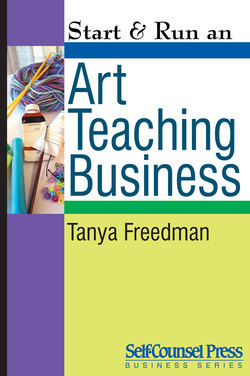Start & Run an Art Teaching Business

Реклама. ООО «ЛитРес», ИНН: 7719571260.
Оглавление
Tanya Freedman. Start & Run an Art Teaching Business
START & RUN AN ART TEACHING BUSINESS
Foreword
Introduction
1. Getting Your Business Started
The Conception of Jolly Good Art
Creative Visualization
Setting goals
Identifying Your Experiences and Transferable Skills
How you can turn your creativity into a business
Look, Listen, and Learn
Apprenticing or teaching, and continuing your education
Learning from children
Contacting other artists and entrepreneurs
Home-Based Studio Versus Rented Studio
Home-based studio
Renting studio space
Zoning
Consider your neighbors
Your Business Name
Conducting a business name search
Searching the Internet for your proposed business name
Making Your Business Legal
Incorporation and other business structures
Sales tax registration
Liability insurance
Police check
2. Becoming A Multifaceted Entrepreneur
Characteristics of an Entrepreneur
Your Strengths and Challenges at the Beginning
Personal Skills Development
Public speaking
Tips and techniques to become a better public speaker
Shyness and fear of rejection
Learning to delegate
Learning Styles
Other Things to Consider
3. Organizing Your Classes
Finding Inspiration for Your Services
Visit the competition
Arts and crafts stores
Take an Artist’s Day
Other areas of inspiration
Number of Students per Class and Student/Teacher Ratio
Dividing Your Classes by Age
Younger age groups
Classes for teenagers and pre-teens
Overlapping ages
Adult classes
Portfolio Preparation
Private Art Classes
Parent-and-Child Classes
Teaching Students with Special Needs
Cerebral palsy
Autism
Attention Deficit Hyperactivity Disorder (ADHD)
Art therapy
Seasonal Programs
Projects for seasonal camps
Food for summer campers
Food allergies
Special Occasion Parties
Birthdays
4. Class Prices and Materials
Pricing
Calculating your price
Captive product pricing
Offering discounts
Last word on pricing: Intangible value
Materials and Supplies
Costs
Materials for classes
Canvas
Paper
Materials for special effects projects
5. Your Business Plan
What Is a Business Plan?
Types of Business Plans
Business Plan Layout
Summary
Your history
Description of your business
Operations and management team
Market analysis and research
Technological strategy
Forecasts and projections
Reality Check
Revisiting Your Business Plan
Second draft of the business plan
Bookkeeping
What is bookkeeping and why keep up-to-date records?
Bookkeeping: How simple or how complicated?
Personal cash flow chart
6. Identifying and Targeting Your Market
What Is Marketing?
Direct and indirect marketing
The Marketing Mix
Place: Location of Your Target Audience
People: Customers, Competition, and Networking
Customers
Competition
Networking
Promotion: Advertising, Brand Awareness, and Reputation
Advertising
Word-of-mouth advertising
Writing articles
Contact the press
Share advertising costs
Fund-raising and charitable events
Raffles
Trade shows
Leaflets
Business cards
Brand awareness
Marketing Plan
7. Creating Your Web Presence
The Importance of Being on the Web
Important Information to Include on Your Website
Including your prices and registration forms on the website
Should You Design Your Website?
Should You Hire a Professional Web Designer?
An Example of a Great Website
8. Interviewing and Hiring Employees
Hiring Suitable Staff
Assistants
Teachers
Training Your Staff
Payment
Staff Incentives
Interviewing
Employee Contract
Safety for Employees and Students
9. Networking
What Is Networking?
Why Network?
Ask for What You Need
Networking Is a Two-Way Street
Volunteering
Reputation
Finding or Creating a Networking Group
Combining Forces
Creating a contract for partnership programs and events
Mentoring and Coaching
Benefits of hiring a mentor or coach
Finding a coach or mentor
You as a mentor and coach
10. Get Organized and Stay Organized
Getting Organized
Organizational styles
The fire starter
The plodder
The convert
The bigger picture
Finding the right system
Time Management
Organize, prioritize, and delegate
Get control of your time
Creating Good Habits
Organizing your files
Action lists
Calendars and program plans
Electronic management
Prioritize Work and Play
Schedule leisure time
Schedule family time
Risks and Signs of Burnout
11. Growing Your Business
Branching into the Next Phase of Your Business
Organize artist’s retreats
Create additional programs
Sell art supplies
Collaborate
Franchise
How Fast Should You Expand Your Business?
11. Appendix — Selected Bibliography
Chapter 1: Getting Your Business Started
Chapter 2: Becoming a Multifaceted Entrepreneur
Chapter 3: Organizing Your Classes
Psychological, Teaching, and Learning Guides
Children with Special Needs
Chapter 4: Class Prices and Materials. Art Books
Craft, Beads, Mosaics, etc
Glass Painting
Silk Painting
Technique
Pastels
Chapter 5: Your Business Plan
Chapter 6: Identifying and Targeting Your Market
Chapter 7: Creating Your Web Presence
Chapter 8: Interviewing and Hiring Employees
Chapter 9: Networking
Chapter 10: Get Organized and Stay Organized
Chapter 11: Growing Your Business
Personal Development and Other Inspirational Books
Acknowledgments
About The Author
Other Titles in the Start & Run Series
Notice To Readers
Self-Counsel Press thanks you for purchasing this ebook
Contents
Отрывок из книги
The role of mentor is an extremely important one, providing guidance, counseling, coaching, and professional advice learned through experience. Effective mentors share not only what they know, and who they know, but also who they are. In Start & Run an Art Teaching Business, Tanya Freedman, my protégée and friend, acts as a mentor to her readers.
For Tanya, being successful isn’t just about believing in herself and her talents, it is also about reaching out and connecting with others who are willing to help her succeed. Tanya has built on her extensive networking skills and business acumen to accomplish exactly what she set out to do: make this a must-read book.
.....
You will need to decide if your home is big enough for a home-based studio. If it is not, then you will need to consider renting space for a studio.
Using an area of your home (or maybe a building on your property) for your studio can have many benefits. For starters, you are in control of your own environment and have no one but your family to answer to about what goes on in your studio; for example, your students can smash tiles to make mosaics and not worry about being too loud when working on their art projects.
.....